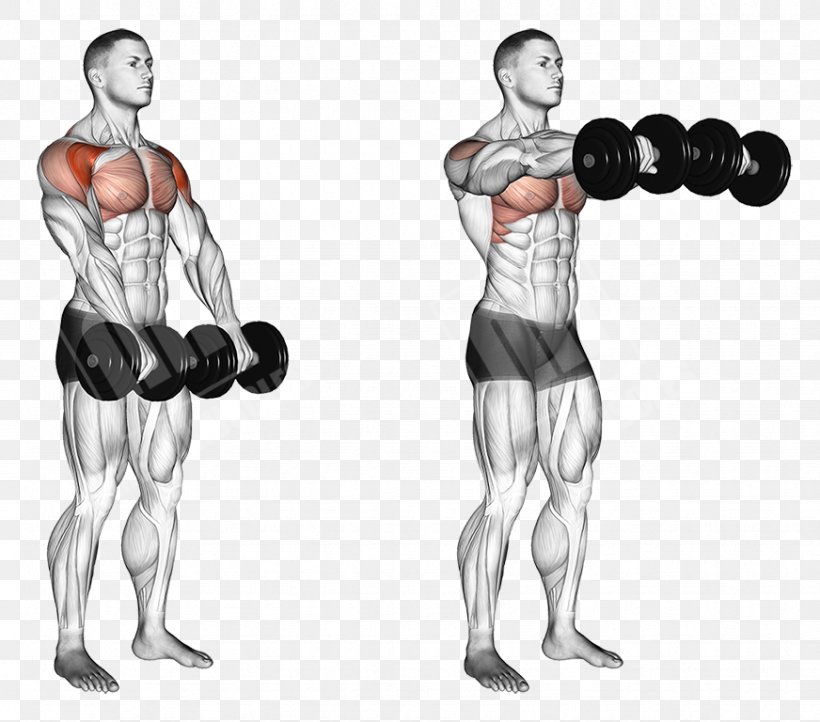What are front delt raises?
Front delt raises are a resistance exercise used in bodybuilding to increase the size and strength of the anterior deltoid. This is the front of the shoulder and is responsible for lifting the arm in a forward motion or pressing movement.
Increasing the size and strength of this muscle gives your shoulder a rounded look and compliments the upper chest. Front raises can be performed with dumbbells, barbells, cables, kettlebells, or just a weight plate.
Advantages of performing front raises.
Your front anterior deltoids are put under tension every time you perform a pressing exercise, such as chest press, shoulder press, or dips. If you press regularly with heavy weights, you may find that your front deltoids are developed and strong enough already and that there is no need to target them with isolation exercises.
If you want to increase the size of your shoulders or make them stronger to improve your pressing PB, the front delt raise is the easiest way to do this. Having a fuller, rounder, front deltoid makes your shoulders look bigger, improves the look of your upper chest, and makes your bicep stand out.
What muscles are worked with front delt raises?
Front raises are an isolation exercise, so pretty much all of the tension and resistance is aimed at the front of the shoulder (anterior deltoid). If you perform front raises in a standing position, your core and back muscles will be activated as stabilisers.

The lateral delts and upper pecs are the secondary muscles targeted with front raises but only play a minor role. For a great, all-around shoulder workout, superset your front raises with lateral or rear delt raises. 3-4 supersets with minimal rest time will get a lot of blood into the shoulders and create a fantastic pump.
How do I do a deltoid front raise?
Front raises are simple to perform. They do not require any machines (unless performing cable front raises) and the movement is easy to perfect.
The dumbbell front raise is the most popular method for carrying out front raises. If you have a rack of dumbbells in front of a mirror, it is best to scale the weights for drop sets and keep a good eye on your form.
- Select your chosen dumbbells and hold b your side with an overhand grip.
- Take a deep breath. Upon exhale, raise one of the dumbbells in a forward, upright motion keeping your arm straight.
- As you raise the dumbbell, you can rotate your wrist inwards 90 degrees so that the weight is horizontal at the top of the movement.
- Lower the weight back to the starting position, rotating the wrist and keeping your arm straight.
- As soon as your weight is back down, repeat the movement with your opposite arm.
Some tips.
Try not to swing the weight. This can cause injury and target your traps and core muscles instead of your anterior deltoid. Many experienced bodybuilders will slightly swing the weight and cheat the first part of the movement and this can produce results if you know what you're doing and your limitations. This is something that you can experiment with once you have gained a lot of experience and stronger supporting muscles such as the rotator cuffs and lateral deltoids.
It is not essential to rotate your wrist when performing front raises. Some find that it is more comfortable to grip the weight this way, but maintaining a 'hammer' grip will work just as well. It puts a little more pressure on the thumbs if you are lifting a heavy weight, but this can be overcome by using a lower, firmer grip or wrist straps.
While the exercise detailed above uses alternating arms. It is possible to use both arms together if using a lighter weight. You can also focus on one arm at a time however, there is no benefit to this and it will obviously take longer to perform the sets. Focusing on one arm at a time can be useful if you are using the exercise to rehabilitate an injured shoulder or rotator cuff.
How do I perform seated deltoid front raises?
Seated front raises are essentially the same as a standing front dumbbell raise. By sitting on a dumbbell bench instead of standing, you are taking your core stabiliser muscles out of the equation allowing more focus to be targeted at your delts.
It is also harder to cheat the movement from a sitting position making it easier to maintain a strict form.

Another advantage of using a seated position is that you can change the angle of the raises. The standard seated front raises are performed in an upright position but by reclining the seat and leaning back, you add more resistance to the beginning of the movement, which will hit the anterior deltoids from a slightly different angle. This is a great way to mix things up and keep the muscles guessing.
Seated raises can also be performed with a plate or kettlebells in the same way, with great results.
How to use cables for front raises.
If your gym has cable resistance machines, they can be used for front raises. Most experienced bodybuilders will opt for free weights as they engage the core and stabiliser muscles to a higher extent, but cables are a great second option.
There are numerous different ways to use a cable machine for front raises. You can select a standing position or wheel a dumbbell bench over for seated front raises. When it comes to grip attachments, you can use a double rope, straight bar, or EZ bar to work both arms at the same time.
If you wish to work your arms individually, use stirrup attachments. A double cable machine will allow you to perform alternating front raises.
Whichever you choose, the movement is essentially the same as a dumbbell front raise. The aim is to lift the weight in front of you with a straight arm by putting all of the tension in the front of your shoulder.
Have a play around with different extensions and methods until you find one that is comfortable to use and lets you really feel the connection with the target muscle.
How to do a plate front raise?
A plate front raise allows you to perform the same movement with just a simple barbell weight plate. The shape of the plate and the double hand grip means that you can not get the same range of motion that you would get with dumbbells.
There is not a lot of tension in the first few inches of a standard dumbbell raise anyway, so the difference is negligible.
The main advantage of using the weight plate is if you want to focus on controlled movement and slow negatives. For some reason, it seems a lot easier with a plate than with dumbbells.
- Select a relatively light weight (lighter than the combined weight you would use for dumbbell raises)
- Grip the weight plate on each side and stand in front of the mirror with the plate resting against your thighs
- Take a deep breath, upon exhaling, slowly raise the weight in front of your face. Make sure your arms are kept in a rigid position and all resistance is being countered by the front of your shoulders.
- When you reach the top of the movement, hold the weight for 2-3 seconds.
- Lower the weight really slowly (4-6 seconds) to the starting position.
- Do not hold your breath on the downwards movement. Take 2-3 short breaths.
- Repeat the movement until failure.
This slow, negative movement puts incredible strain on the muscle after the first few reps. The extra time under tension will break down those fibres and create a great pump.
When the weight is at the top of the movement in front of your face. You can rotate it side to side a couple of times. This puts extra strain on the deltoids which will promote more growth in the shoulders.
Front delt raise alternatives?
There are many ways to perform front raises. The above options are the most popular for targeting the front deltoid, but any similar, resistance movement will have the same effect.
If you are experimenting with different methods, make sure that you are not putting dangerous strain on your wrists, biceps or rotator cuffs. If a movement feels awkward or is painful to perform from the outset, go back to basics with one of the above alternatives.
Other exercises that work the front deltoids are...
Shoulder press
The dumbbell shoulder press is a great exercise for targeting the muscles in the shoulders making it a good alternative to front delt raises. If you are looking to add mass to your shoulders and triceps, you can use heavy dumbbells or a barbell. This exercise can also be done with resistance bands or cables.
Chest press
The bench press is another way to develop the front delts, however, this exercise can predominantly targets the chest and triceps. If you are using a barbell, be sure to arch your back and tuck your chin to ensure safety. You can also do this exercise with dumbbells or resistance bands.
Conclusion.
The best way to add overall mass to the shoulders is with compound, heavy overhead pressing movements. Front delt raises, lateral raises and rear delt raises are great for defining the muscle and hypertrophy so should be a part of any good bodybuilding program.
If your lateral delts and rear delts are booming and your front delts are lagging behind, take a break from overhead pressing and rows and focus on front delt raises until they catch up.
Happy lifiting!
FREE TRAINING PROGRAMS
Gymenix offers a selection of free training programs to suit all abilities and goals. Click on the links below for FREE access.





.png)




